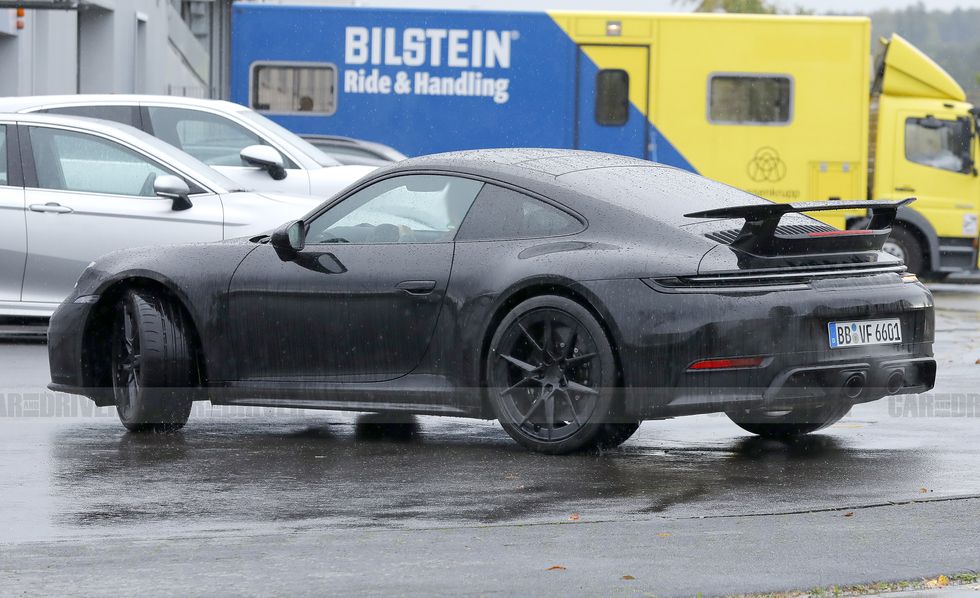Overview
Few manufacturers have mastered the art of reinvention like Porsche has with its 911. For over five decades, Porsche has continued to adapt, update, and finesse its most famous model’s rear-engine blueprint, careful never to the dilute its core identity or trademark driving experience. The upcoming 2025 Porsche 911, designated 992.2 in Porsche vernacular, promises to continue that calculated evolution with the usual mild styling revisions and power upgrades, but hybridization is not very far off. Although the precise timing remains in flux, internal documents we’ve seen indicate that both a 48-volt system using an integrated starter-generator and a more radical hybrid system, slated for later introduction, are both in the cards. The next 911’s interior and exterior will also receive attention, the latter with revised front and rear fasciae, lighting elements, and updated aerodynamics. The coupe will remain the cornerstone of the lineup, and the Cabriolet and Targa models will continue to deliver the same sharp handling and visceral thrills while letting the sun shine in. With so many variants trading under the 911 banner keeping the scorecard current can be difficult. It’s for that reason that we review the even more performance focused and expensive Turbo and GT3 models separately. This review covers the “standard” 911 lineup, which currently encompass the Carrera, Carrera S, Carrera T, and GTS models. These 911 models deliver balanced performance in the vein of a Grand Tourer; always engaging, they can effortlessly toggle between intense and relaxed behavior, making them the most versatile 911s of the lineup.
What’s New for 2025?
The big 911 news for 2025 is the shuffling of powertrains. Additionally, the exterior receives numerous updates, including new bumpers, wheels, lights, mirrors, and aero aids. Early photos indicate the front end features five vertical louvers in each of the outboard air intakes; the louvers appear to be adjustable to facilitate better cooling of the brakes or to divert air to the radiators. We expect trim-specific bumper treatments, an active lower front air dam for improved aerodynamics, and single or dual exhaust configurations. Likewise, the interior will receive updates, but how significant they’ll be remains to be seen.
Pricing and Which One to Buy
The price of the 2025 Porsche 911 is expected to start around $117,000 and go up to $174,000 depending on the trim and options.
Porsche has not yet released pricing for the 2025 911 and we aren’t sure exactly how it will be equipped. Spreading the 911 across a wide performance and pricing delta is a marketing strategy that has served Porsche well, so we don’t expect any radical changes to the sports car’s trim level lineup any time soon. Last year, we recommended the Carrera S as it offered a remarkable performance-to-price ratio, with enough features to make it versatile transport as well. The big question for 2025 is the final spec of the pending 3.6-liter flat-six in the GTS; it could pack enough additional performance to make a solid argument for its approximately $20k price premium.
Engine, Transmission, and Performance
Our sources report that the twin-turbo 3.0-liter flat-six in the Carrera and Carrera S will continue with the same displacement but will see an increase in horsepower and torque. The base Carrera’s essentially unchanged twin-turbo 3.0-liter in will dial up an additional 11 hp and 16 pound-feet of torque for totals of 390 hp and 347 pound-feet. The Carrera S sees similar increases of 11 hp and 16 pound-feet for a total output of 454 hp and 406 pound-feet. Given the amount and parity of the output increase across both models, it’s highly possible the boost comes from the 48-volt mild hybrid system Porsche has been developing. A higher-performance version with up to 520 hp is rumored to be in the works. Additional changes are anticipated cross the lineup, with the 911 Turbo and Turbo S and 911 GT3 and 911 GT3 RS receiving similar bumps in output, as well as the introduction of an advanced hybrid system.
As more information becomes available, we’ll update this story with more details about:
- 0–60-MPH Times
- Fuel Economy and Real-World MPG
- Interior, Comfort, and Cargo
- Infotainment and Connectivity
- Safety and Driver-Assistance Features
- Warranty and Maintenance Coverage


